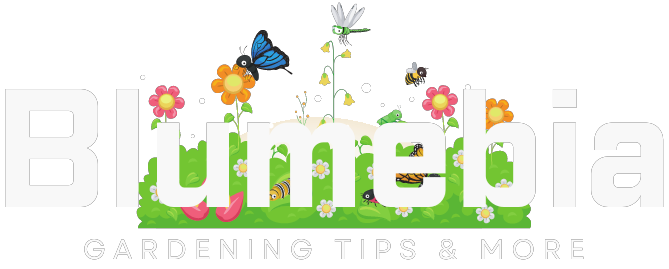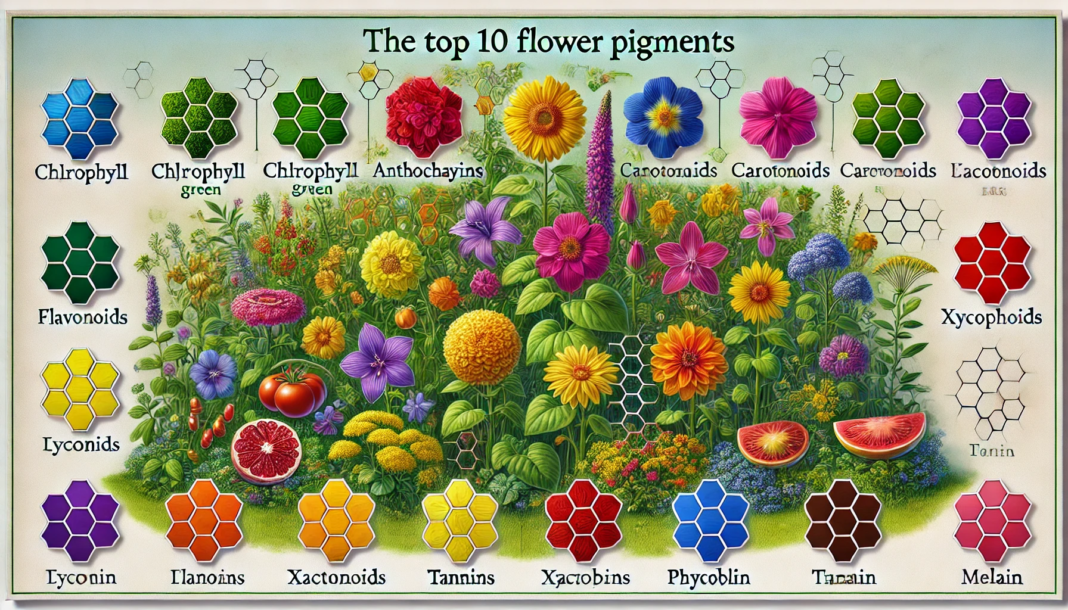Flower pigments are responsible for the vibrant colors seen in blossoms, playing a crucial role in attracting pollinators, protecting against UV radiation, and more. This article explores the top 10 flower pigments, detailing their characteristics, functions, and examples.
1. Chlorophyll
Characteristics and Color
Chlorophyll is the green pigment essential for photosynthesis, the process by which plants convert light energy into chemical energy. It absorbs light primarily in the blue and red wavelengths and reflects green, giving leaves and many flowers their green color.
Functions
- Photosynthesis: Chlorophyll absorbs light energy to convert carbon dioxide and water into glucose and oxygen.
- Growth and Development: Essential for the growth and health of plants, enabling energy production.
Examples
- Green Flowers: Some flowers, like the green chrysanthemum, display chlorophyll in their petals.
- Leaves: The most abundant green pigment in the leaves of all plants.
Importance
Chlorophyll is crucial for plant survival, providing the energy necessary for growth and development. Its presence in flowers can indicate photosynthetic activity in those parts.
2. Anthocyanins
Characteristics and Color
Anthocyanins are water-soluble pigments that can appear red, purple, or blue depending on the pH of the cell sap. They are part of the flavonoid group and are found in the vacuoles of plant cells.
Functions
- Attracting Pollinators: Bright and varied colors attract different pollinators.
- Protection: Provide antioxidant protection against environmental stresses.
Examples
- Roses (Rosa spp.): Many red and pink roses owe their color to anthocyanins.
- Blueberries (Vaccinium spp.): The blue color is due to high anthocyanin content.
Importance
Anthocyanins play a significant role in the aesthetics of flowers, enhancing their appeal to pollinators and humans. They also offer protective benefits to the plants.
3. Carotenoids
Characteristics and Color
Carotenoids are yellow, orange, and red pigments found in the plastids of plant cells. They include compounds such as beta-carotene, lutein, and zeaxanthin.
Functions
- Photosynthesis: Assist in light absorption and protect chlorophyll from photo-damage.
- Attracting Pollinators: Bright colors attract a variety of pollinators.
Examples
- Marigolds (Tagetes spp.): Exhibit bright orange and yellow hues due to carotenoids.
- Tomatoes (Solanum lycopersicum): Contain high levels of lycopene, a red carotenoid.
Importance
Carotenoids are essential for photosynthesis and play a critical role in attracting pollinators, which is vital for plant reproduction.
4. Flavonoids
Characteristics and Color
Flavonoids are a diverse group of phytonutrients found in almost all fruits and vegetables, contributing to a wide range of colors including yellow, red, blue, and purple.
Functions
- UV Protection: Absorb UV light, protecting plant tissues from damage.
- Antioxidants: Provide antioxidant benefits, reducing oxidative stress.
Examples
- Pansies (Viola tricolor): Display a variety of colors due to different flavonoids.
- Petunias (Petunia spp.): Known for their vibrant colors, influenced by flavonoid content.
Importance
Flavonoids enhance the visual appeal of flowers and offer protective benefits against environmental stresses, contributing to the plant’s overall health.
5. Betalains
Characteristics and Color
Betalains are red and yellow pigments found in the vacuoles of plant cells. They are unique to the Caryophyllales order of plants and are divided into betacyanins (red-violet) and betaxanthins (yellow).
Functions
- Attracting Pollinators: Bright colors attract specific pollinators.
- Antioxidant Activity: Provide antioxidant protection.
Examples
- Beets (Beta vulgaris): The deep red color of beets is due to betacyanins.
- Bougainvillea (Bougainvillea spp.): The vibrant bracts display betalain pigments.
Importance
Betalains contribute to the striking colors of flowers and provide antioxidant benefits, enhancing the plant’s resilience to environmental stresses.
6. Xanthophylls
Characteristics and Color
Xanthophylls are yellow pigments that are a type of carotenoid. They are responsible for the yellow coloration in many flowers and are involved in the photosynthetic process.
Functions
- Light Absorption: Assist in photosynthesis by absorbing light.
- Protection: Protect against photooxidative damage.
Examples
- Sunflowers (Helianthus annuus): The yellow petals are rich in xanthophylls.
- Corn (Zea mays): The yellow kernels contain high levels of xanthophylls.
Importance
Xanthophylls play a crucial role in photosynthesis and provide vibrant yellow coloration that attracts pollinators, supporting plant reproduction.
7. Lycopene
Characteristics and Color
Lycopene is a red pigment found in certain fruits and vegetables. It is a type of carotenoid known for its strong antioxidant properties.
Functions
- Coloration: Provides red coloration to attract pollinators and seed dispersers.
- Antioxidant Activity: Protects cells from oxidative damage.
Examples
- Tomatoes (Solanum lycopersicum): The red color of ripe tomatoes is due to lycopene.
- Watermelons (Citrullus lanatus): The red flesh contains lycopene.
Importance
Lycopene enhances the red coloration of flowers and fruits, attracting pollinators and animals that aid in seed dispersal. Its antioxidant properties also benefit the plant’s health.
8. Tannins
Characteristics and Color
Tannins are brown pigments that can be found in various parts of plants, including leaves, bark, and flowers. They are polyphenolic compounds known for their astringent properties.
Functions
- Defense: Provide protection against herbivores and pathogens.
- Coloration: Contribute to brown and earthy tones in flowers and foliage.
Examples
- Oak Leaves (Quercus spp.): Display brown coloration due to tannins.
- Tea (Camellia sinensis): The brown color of tea leaves is due to tannins.
Importance
Tannins play a defensive role in plants, deterring herbivores and protecting against microbial infections. They also contribute to the aesthetic diversity of plant coloration.
9. Phycobilins
Characteristics and Color
Phycobilins are water-soluble pigments found in some algae, imparting red or blue colors. They are associated with the protein complexes phycobiliproteins and are important for light absorption.
Functions
- Photosynthesis: Assist in capturing light energy for photosynthesis in algae.
- Coloration: Provide distinctive red and blue hues.
Examples
- Red Algae (Rhodophyta): Contain phycoerythrin, a red phycobilin.
- Cyanobacteria (Blue-Green Algae): Contain phycocyanin, a blue phycobilin.
Importance
Phycobilins are crucial for the photosynthetic efficiency of algae, allowing them to thrive in various aquatic environments. They also contribute to the unique coloration of these organisms.
10. Melanin
Characteristics and Color
Melanin is a group of pigments found in some plants, fungi, and animals, providing brown to black coloration. In plants, melanin is less common but can be found in seeds and flowers.
Functions
- Protection: Provides protection against UV radiation and oxidative stress.
- Coloration: Contributes to dark colors in seeds and flowers.
Examples
- Black Tulips (Tulipa spp.): The dark coloration is due to melanin.
- Nigella Seeds (Nigella sativa): Black seeds contain melanin.
Importance
Melanin enhances the dark coloration of certain plant parts, contributing to their aesthetic appeal and providing protective benefits against environmental stresses.
Conclusion
Flower pigments play a vital role in the life of plants, contributing to their survival, reproduction, and interactions with the environment. From the green hues of chlorophyll to the vibrant reds of anthocyanins and carotenoids, each pigment serves specific functions that enhance the plant’s ability to attract pollinators, protect against stress, and thrive in diverse habitats. Understanding these pigments deepens our appreciation for the complexity and beauty of the plant world.
FAQs
What is the primary function of chlorophyll in flowers?
Chlorophyll’s primary function is to facilitate photosynthesis by absorbing light energy and converting it into chemical energy, which is essential for the growth and development of plants.
How do anthocyanins contribute to flower coloration?
Anthocyanins are water-soluble pigments that can appear red, purple, or blue depending on the pH of the cell sap. They attract pollinators with their bright and varied colors and provide antioxidant protection.
Why are carotenoids important in plants?
Carotenoids are important for photosynthesis as they assist in light absorption and protect chlorophyll from photo-damage. They also attract pollinators with their bright yellow, orange, and red colors.
What role do flavonoids play in plant health?
Flavonoids provide UV protection by absorbing UV light, protecting plant tissues from damage. They also offer antioxidant benefits, reducing oxidative stress in plants.
How do betalains differ from anthocyanins?
Betalains are red and yellow pigments found in the Caryophyllales order of plants, whereas anthocyanins are more widely distributed and can appear red, purple, or blue. Both pigments attract pollinators and provide antioxidant protection.



